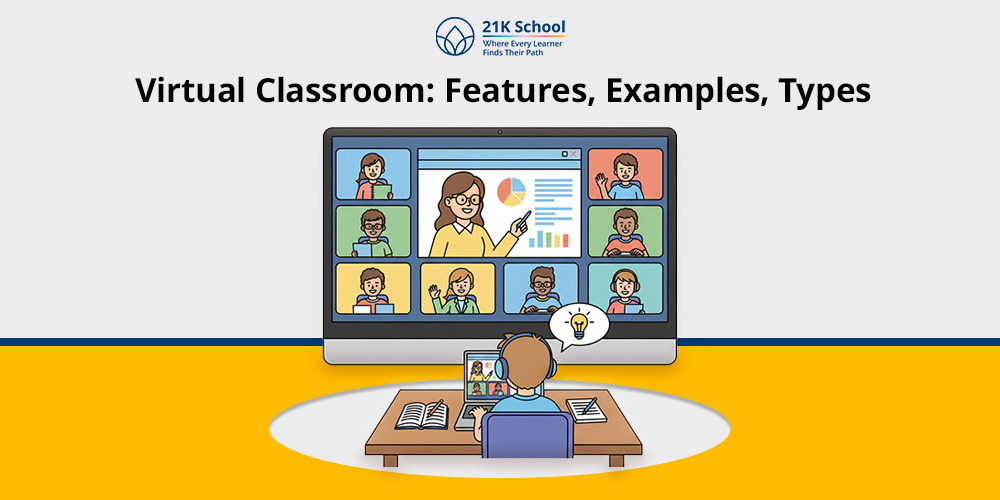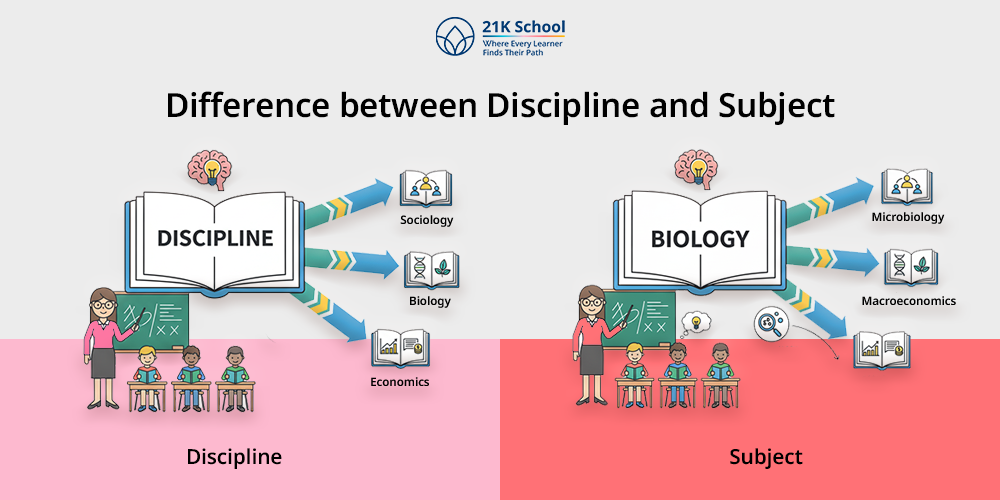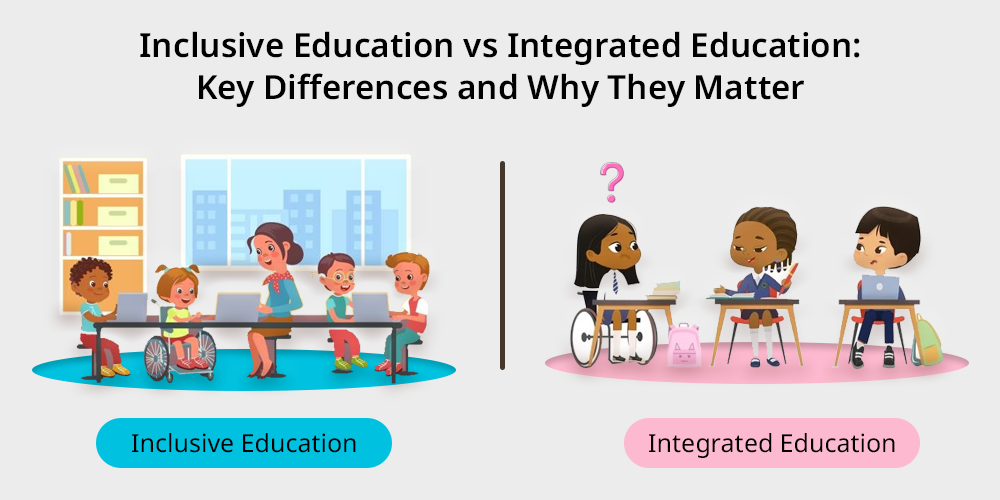
Education is no longer about uniformity. It’s becoming much more dynamic and much more human.
As schools around the globe rethink how they educate learners, words like integrated education and inclusive education are moving to the centre of the conversation.
Even though these ideas may sound similar, they create drastically different realities in the classroom. Knowing the difference between them is important for teachers, parents, students and policymakers.
Let’s examine the subtle yet powerful distinction between these two strategies and why it matters.
Contents
What is Inclusive Education?
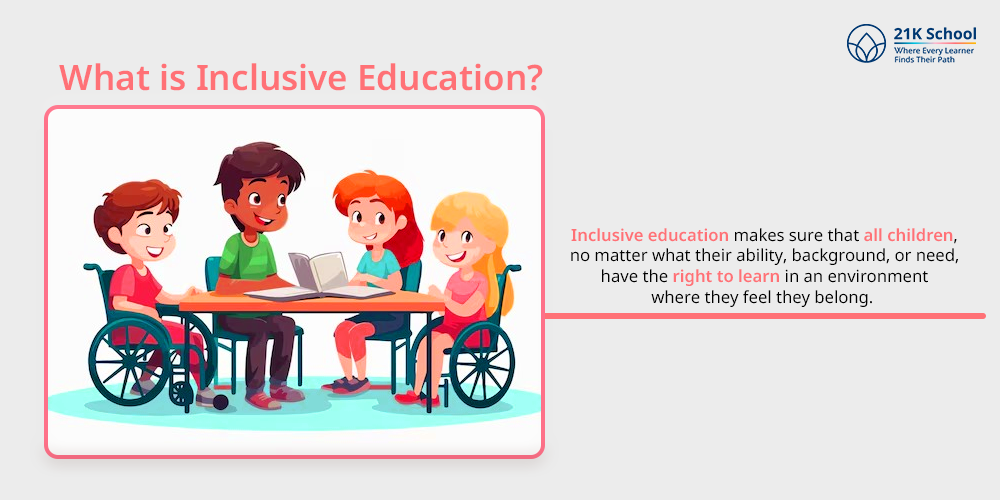
Inclusive education makes sure that all children, no matter what their ability, background, or need, have the right to learn in an environment where they feel they belong.
Under this model, children with disabilities, learning differences, or any type of diversity have the same classrooms, curriculum, and expectations as their peers.
Inclusion is not about trying to fit kids into a system. It’s about fitting the system to the kid.
An inclusive classroom is dynamic and participatory. Educators modify their methods, apply differentiated instruction, and frequently incorporate assistive technologies to make the content accessible and user-friendly for all learners.
Social interaction is facilitated, and all learners are viewed as contributors, rather than issues to be addressed.
The benefits of inclusive education are far and wide. This method does more than bridge academic divides. It creates empathy, develops friendships despite differences, and builds confidence in all students.
Whether it’s a student with autism, a new language learner, or someone with temporary difficulties, everyone belongs. Schools that employ inclusive education are providing what education should be: universal, respectful, and empowering.
Read on to learn how to promote inclusive education in schools ?
What is Integrated Education?
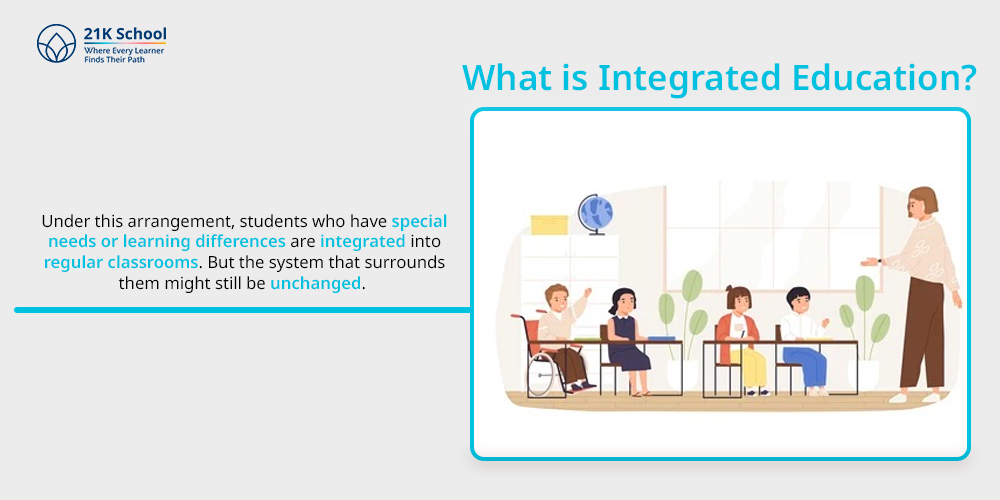
Integration is a step toward inclusion, but it’s not the entire picture.
Under this arrangement, students who have special needs or learning differences are integrated into regular classrooms. But the system that surrounds them might still be unchanged.
While children might occupy space with peers, the support, adaptations, and attitudes that characterise inclusion might be lacking. The roots of integrated education can be found in policies designed to “mainstream” kids with disabilities.
Then, it was an innovative concept: transferring students out of separate schools into regular schools. Integration, however, works on the principle that students should conform to the current system, rather than vice versa.
This process typically creates parallel strands in the same room. Some may learn differently, sit apart, or have aides, which only emphasises the differences instead of erasing them.
Well-meaning integration can inadvertently reinforce labels.
Picture a dyslexic student sitting in the same room as all the others but being given worksheets in a format that they can hardly read. Technically, they’re “included.” In reality, they’re still outside looking in.
Integrated education brings you in.
Inclusive education invites you to sit at the table.
Inclusive vs Integrated Education: Key Differences
Understanding the difference between inclusive and integrated education is more than semantics; it is an indication of a new perspective on learning, diversity, and what education is for.
Although these two terms are sometimes used interchangeably, they are derived from two completely different frames of mind. And when practised in actual classrooms, the results they yield can be immensely different.
To summarise the key difference between integrated and inclusive education, take a look at the table below:
| ASPECT | INTEGRATED EDUCATION | INCLUSIVE EDUCATION |
| Core Approach | Students must adapt to the existing system. | The system adapts to the needs of all students. |
| Focus | Physical placement in regular classrooms. | Equal participation and a sense of belonging. |
| Curriculum Design | Standard curriculum with a few changes. | Flexible, learner-centred curriculum. |
| Teacher’s Role | Mainly general educators, with limited special support. | Collaborative teaching with special educators involved. |
| Social Interaction | Social separation may still exist. | Promotes peer interaction and collaboration. |
| Outcome | Partial inclusion with limited benefits. | Holistic development and improved learning for all. |
| Long-term Impact | Can unintentionally sustain separation. | Builds inclusive mindsets and diverse-ready citizens. |
1. Purpose and Philosophy
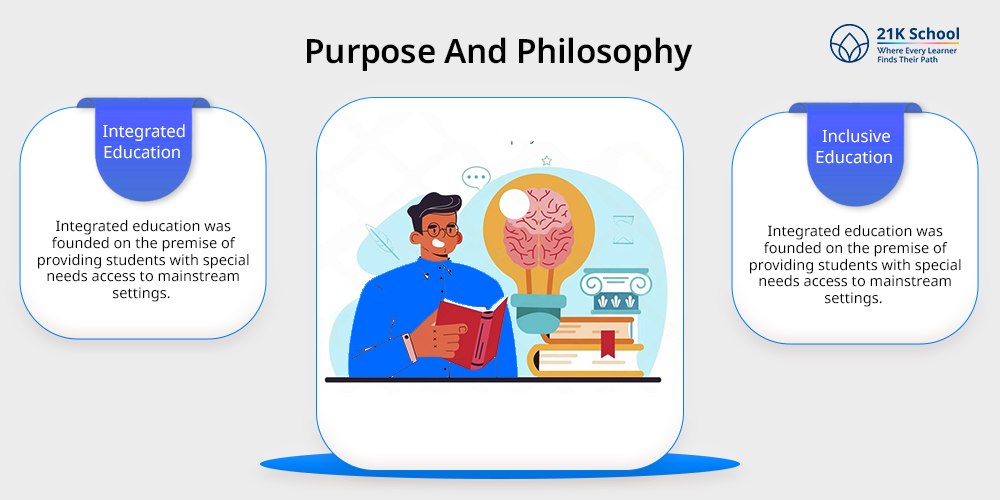
Integrated education was founded on the premise of providing students with special needs access to mainstream settings. It was a move away from segregation; a reaction to decades of separating students by perceived ability.
But the underlying presumption still existed: the “mainstream” is the norm, and others need to attempt to fit into it.
Inclusive education, by contrast, begins in a position of acceptance. It does not view diversity as an exception to the rule but rather as a basis of any classroom.
Inclusion does not query whether a student belongs in a system; it questions how a system can change to serve the student.
2. System vs Student Adaptation
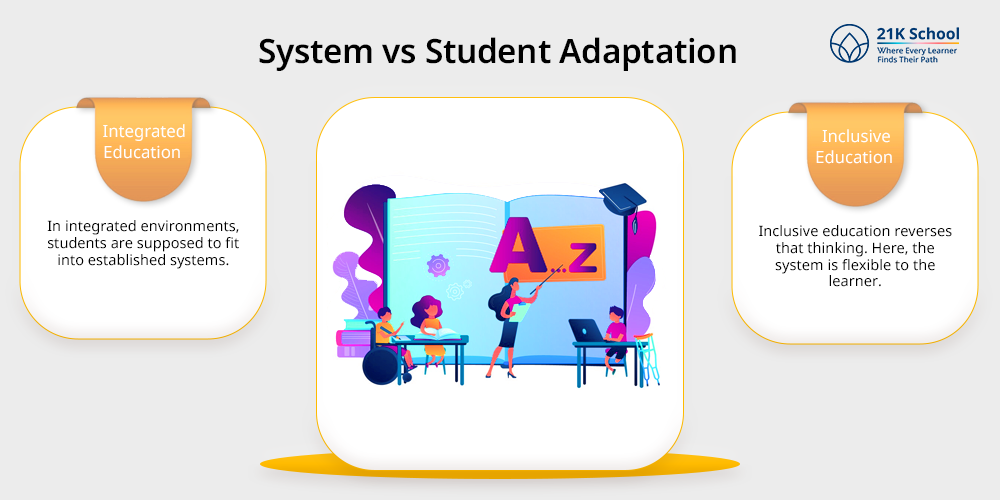
In integrated environments, students are supposed to fit into established systems. They are placed in regular classrooms, but efforts to modify curriculum, teaching pace, or assessment measures are minimal.
A dysgraphic student might be sitting in the same room as his or her peers but struggling in silence because no structural accommodation has been made.
Inclusive education reverses that thinking. Here, the system is flexible to the learner. Teachers employ Universal Design for Learning (UDL), scaffolding, and customised teaching methods.
The setting is geared up before the students’ arrival, not upon the emergence of a challenge. It’s proactive, not reactive.
3. Curriculum and Instructional Design
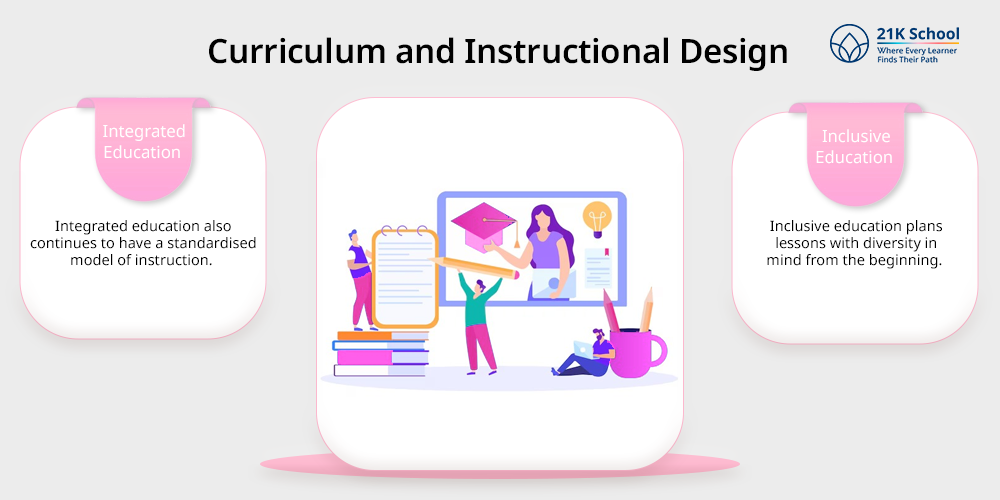
Integrated education also continues to have a standardised model of instruction. If the student can keep up, they stay in the class. If they fall behind, they might be taken out for individual sessions or get a watered-down version of the lesson. This provides parallel tracks in the same classroom.
Inclusive education plans lessons with diversity in mind from the beginning. It accommodates several modes of instruction–visual, auditory, kinesthetic–so that no one is excluded.
Assessment is adaptable. Teamwork is fostered. Assistive technology, when required, is blended in smoothly. The curriculum becomes a living document, always adapting with the learner.
4. Teacher Roles and Collaboration
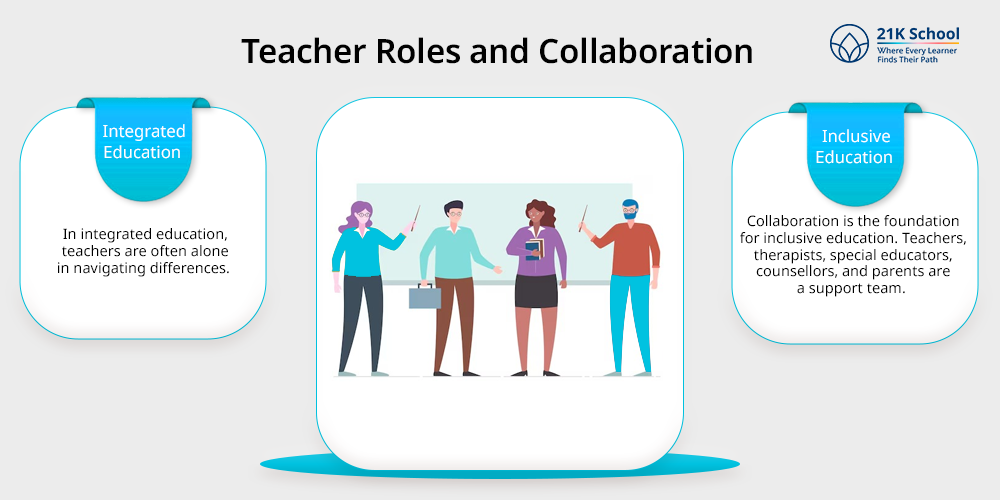
In integrated education, teachers are often alone in navigating differences. Special educators might be consulted occasionally, but general educators carry the primary load, and they may not have the training to support diverse needs effectively.
Collaboration is the foundation for inclusive education. Teachers, therapists, special educators, counsellors, and parents are a support team.
Planning is collaborative. Professional development is ongoing. The classroom becomes a common place of learning for teachers as well as students.
Also, inclusive teachers recognise each student’s diversity as an asset, not as something to be worked around.
5. Social Inclusion and Peer Relationships
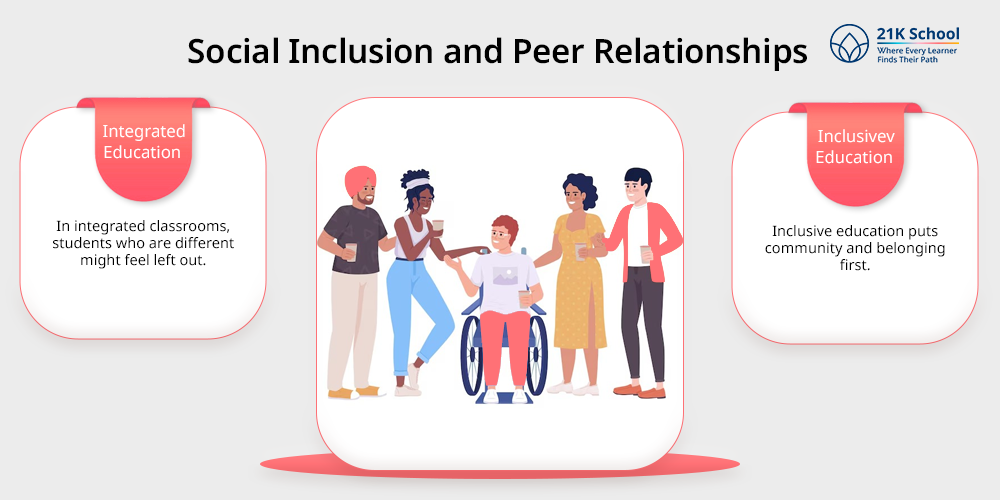
One of the most obvious distinctions is in the social life of the student.
In integrated classrooms, students who are different might feel left out. They may be present but distant. Activities such as group work, play, or discussions can quietly perpetuate separation, particularly if peers are not taught to interact inclusively.
It is first important to understand how children socialise with each other ?
Inclusive education puts community and belonging first. Students learn to work with others who think, communicate, or move differently than they do. There’s a deliberate emphasis on empathy, kindness, and supporting one another.
The outcome? Closer peer relationships and classrooms that reflect real-world diversity.
6. Educational and Emotional Outcomes
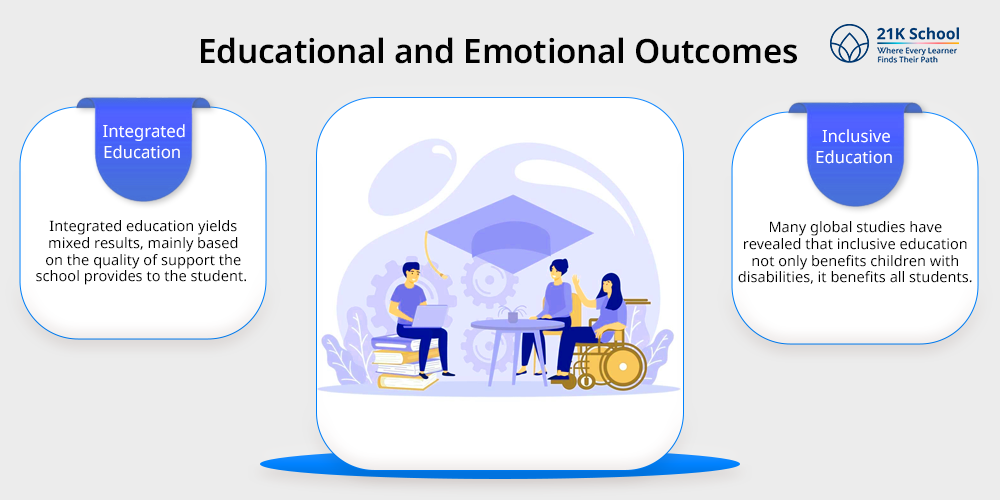
Many global studies have revealed that inclusive education not only benefits children with disabilities, it benefits all students. Students in inclusive environments tend to:
- Perform better in school, thanks to customised instruction
- Improve communication and teamwork skills
- Demonstrate greater emotional intelligence and empathy
- Better equipped to face workplaces that require teamwork and diversity
Meanwhile, integrated education yields mixed results, mainly based on the quality of support the school provides to the student. Without adequate resources, the student could be left isolated even when they are “included” on paper.
7. Long-Term Impact
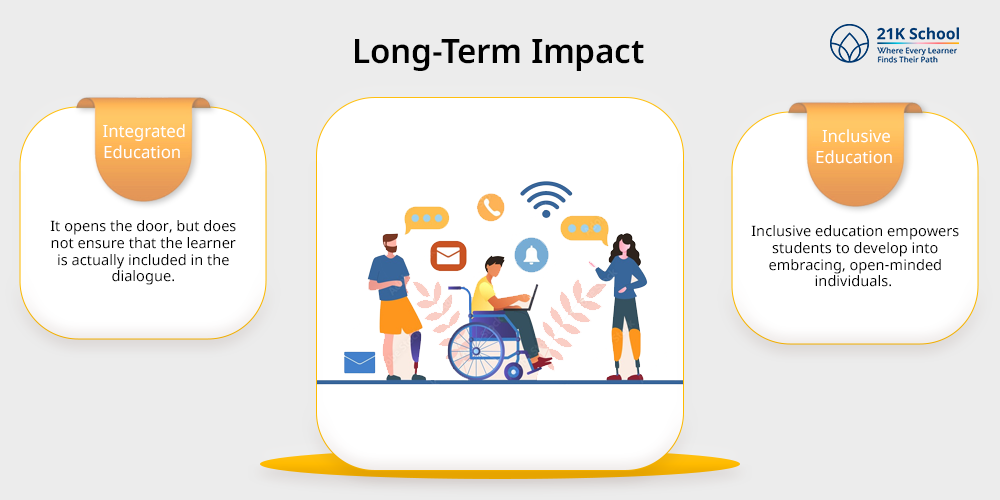
Inclusive education empowers students to develop into embracing, open-minded individuals. As kids learn in environments that mirror society, they take those lessons out into the real world; into colleges, workplaces and communities.
It sets the foundation for more inclusive communities as well. These kids will be the most likely to get in the faces of discriminators, support disparate voices, and create systems welcoming difference rather than fearing it.
Integration, though a step of necessity in history, does not necessarily result in this change. It opens the door, but does not ensure that the learner is actually included in the dialogue.
Conclusion: Moving Beyond Integration to True Inclusion
The future of schooling is in building systems that view every student as a part of it. Where integration helped us inch towards educational equity, the time has come to move more.
Inclusion is no longer a dream, it’s a requirement. It builds schools where learning is an experience shared, where differences don’t isolate, and where achievement looks different for all, but is no less important.
21K School, a top online education platform in India, is leading this change. Through customised learning plans, adaptive methods, and technology-enabled instruction, they’re constructing an education system where inclusion isn’t an add-on, but the starting point.
As we reimagine what classrooms can become, let’s go beyond integration. Let’s create schools that don’t just welcome everyone but make everyone shine.

